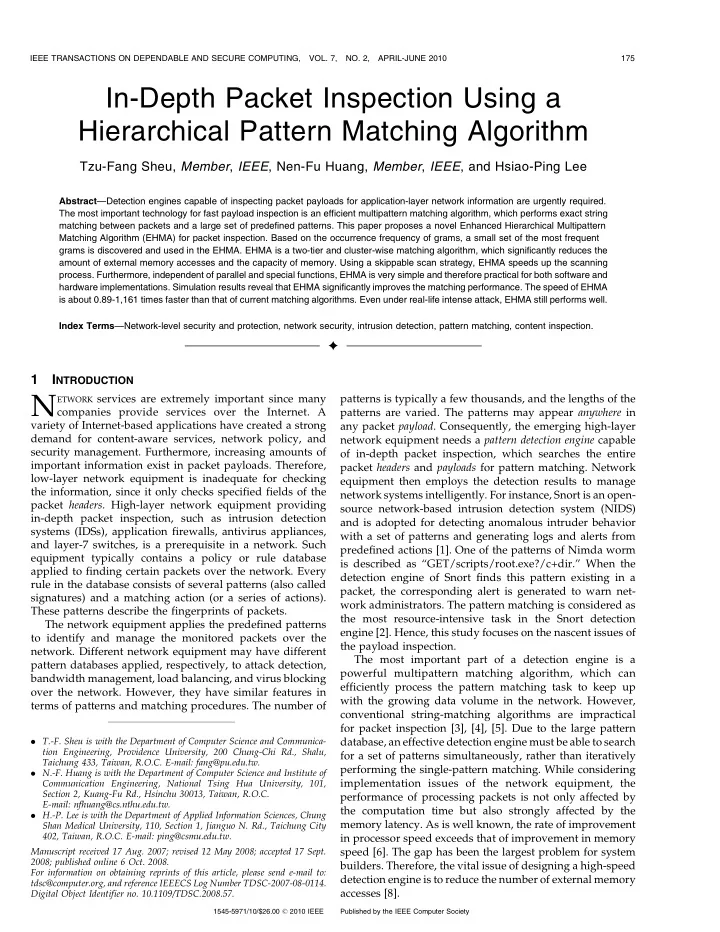

IEEE TRANSACTIONS ON DEPENDABLE AND SECURE COMPUTING, VOL. 7, NO. 2, APRIL-JUNE 2010 175 In-Depth Packet Inspection Using a Hierarchical Pattern Matching Algorithm Tzu-Fang Sheu, Member , IEEE , Nen-Fu Huang, Member , IEEE , and Hsiao-Ping Lee Abstract —Detection engines capable of inspecting packet payloads for application-layer network information are urgently required. The most important technology for fast payload inspection is an efficient multipattern matching algorithm, which performs exact string matching between packets and a large set of predefined patterns. This paper proposes a novel Enhanced Hierarchical Multipattern Matching Algorithm (EHMA) for packet inspection. Based on the occurrence frequency of grams, a small set of the most frequent grams is discovered and used in the EHMA. EHMA is a two-tier and cluster-wise matching algorithm, which significantly reduces the amount of external memory accesses and the capacity of memory. Using a skippable scan strategy, EHMA speeds up the scanning process. Furthermore, independent of parallel and special functions, EHMA is very simple and therefore practical for both software and hardware implementations. Simulation results reveal that EHMA significantly improves the matching performance. The speed of EHMA is about 0.89-1,161 times faster than that of current matching algorithms. Even under real-life intense attack, EHMA still performs well. Index Terms —Network-level security and protection, network security, intrusion detection, pattern matching, content inspection. Ç 1 I NTRODUCTION N patterns is typically a few thousands, and the lengths of the ETWORK services are extremely important since many companies provide services over the Internet. A patterns are varied. The patterns may appear anywhere in variety of Internet-based applications have created a strong any packet payload . Consequently, the emerging high-layer demand for content-aware services, network policy, and network equipment needs a pattern detection engine capable security management. Furthermore, increasing amounts of of in-depth packet inspection, which searches the entire important information exist in packet payloads. Therefore, packet headers and payloads for pattern matching. Network low-layer network equipment is inadequate for checking equipment then employs the detection results to manage the information, since it only checks specified fields of the network systems intelligently. For instance, Snort is an open- packet headers . High-layer network equipment providing source network-based intrusion detection system (NIDS) in-depth packet inspection, such as intrusion detection and is adopted for detecting anomalous intruder behavior systems (IDSs), application firewalls, antivirus appliances, with a set of patterns and generating logs and alerts from and layer-7 switches, is a prerequisite in a network. Such predefined actions [1]. One of the patterns of Nimda worm equipment typically contains a policy or rule database is described as “GET/scripts/root.exe?/c+dir.” When the applied to finding certain packets over the network. Every detection engine of Snort finds this pattern existing in a rule in the database consists of several patterns (also called packet, the corresponding alert is generated to warn net- signatures) and a matching action (or a series of actions). work administrators. The pattern matching is considered as These patterns describe the fingerprints of packets. the most resource-intensive task in the Snort detection The network equipment applies the predefined patterns engine [2]. Hence, this study focuses on the nascent issues of to identify and manage the monitored packets over the the payload inspection. network. Different network equipment may have different The most important part of a detection engine is a pattern databases applied, respectively, to attack detection, powerful multipattern matching algorithm, which can bandwidth management, load balancing, and virus blocking efficiently process the pattern matching task to keep up over the network. However, they have similar features in with the growing data volume in the network. However, terms of patterns and matching procedures. The number of conventional string-matching algorithms are impractical for packet inspection [3], [4], [5]. Due to the large pattern . T.-F. Sheu is with the Department of Computer Science and Communica- database, an effective detection engine must be able to search tion Engineering, Providence University, 200 Chung-Chi Rd., Shalu, for a set of patterns simultaneously, rather than iteratively Taichung 433, Taiwan, R.O.C. E-mail: fang@pu.edu.tw. performing the single-pattern matching. While considering . N.-F. Huang is with the Department of Computer Science and Institute of implementation issues of the network equipment, the Communication Engineering, National Tsing Hua University, 101, Section 2, Kuang-Fu Rd., Hsinchu 30013, Taiwan, R.O.C. performance of processing packets is not only affected by E-mail: nfhuang@cs.nthu.edu.tw. the computation time but also strongly affected by the . H.-P. Lee is with the Department of Applied Information Sciences, Chung memory latency. As is well known, the rate of improvement Shan Medical University, 110, Section 1, Jianguo N. Rd., Taichung City 402, Taiwan, R.O.C. E-mail: ping@csmu.edu.tw. in processor speed exceeds that of improvement in memory Manuscript received 17 Aug. 2007; revised 12 May 2008; accepted 17 Sept. speed [6]. The gap has been the largest problem for system 2008; published online 6 Oct. 2008. builders. Therefore, the vital issue of designing a high-speed For information on obtaining reprints of this article, please send e-mail to: detection engine is to reduce the number of external memory tdsc@computer.org, and reference IEEECS Log Number TDSC-2007-08-0114. accesses [8]. Digital Object Identifier no. 10.1109/TDSC.2008.57. 1545-5971/10/$26.00 � 2010 IEEE Published by the IEEE Computer Society
Recommend
More recommend